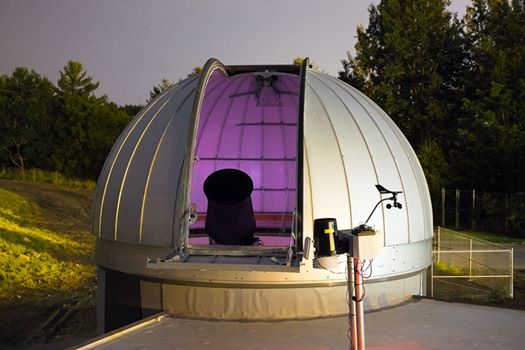Maynard F. Jordan Observatory

The Maynard F. Jordan Observatory was part of the construction of the Versant Power Astronomy Center that began in 2012. In 2014 both the new Jordan Planetarium and the observatory were finished. Its proximity to the planetarium allows it to be integrated more easily into the whole astronomy experience for visitors to the Astronomy Center.
The Jordan Observatory is equipped with several telescopes, both mounted and portable. The main attraction is the PlaneWave CDK 20 optical reflecting telescope. This 20 inch scope provides the university with a modern research-grade telescope that can be used by faculty and students to perform original research projects in observational astronomy. Unlike the antique Alvan-Clark refractor that had been used by the physics department in the past, the PlaneWave scope does not have an eyepiece for visitors to look through. All imaging is done digitally with the use of a CCD camera and fed to a computer monitor. This allows the telescope to be controlled remotely from almost anywhere in the world. Working with an automated German-equatorial mount and automated dome, the telescope can orient itself to point at anything in the sky with the push of a button.
Click here to see the gallery of images taken with the CDK20.


Through the ACP Observatory Control Software the telescope can be controlled remotely. To protect the telescope, there is a sophisticated weather system on the roof of the observatory that has overrides for the dome controls. If given a list of objects to image over the course of the night, the weather suite will first determine if conditions are safe to open the dome and the software will prioritize the objects based on their position. If at any time the weather changes, the dome will close and reopen if it detects that the sky has cleared up. This process allows users to request an observation, go to bed and collect their images in the morning.
Several portable scopes also operate out of the observatory, mostly for the use of AST 110 lab students. The observatory owns two Dobsonian reflector telescopes (a six inch and a twelve inch) as well as a five inch Schmidt-Cassegrain and two Hydrogen-Alpha telescopes for solar viewing (these telescopes are specifically designed for solar observation. You should NEVER otherwise point a telescope at the sun).
In the past, light pollution has had a strong impact on the sky quality at the observatory. With the old Jordan Observatory located in the middle of campus and new buildings springing up and bringing lights with them, the darkness quickly deteriorated. Part of the location decision for the new observatory was that it was on the outer edge of campus, away from most of the bright lights. To ensure that the new equipment operates in the best environment possible, the parking lot between the planetarium and observatory has been outfitted with red area lighting. When the sky is too cloudy for observing the parking lot will have standard white LED fixtures, but on clear nights the white lights can be turned off completely and replaced with much dimmer red LEDs. Red light is much less damaging to night vision, allowing the parking lot to be lit for safety, but keep the sky dark for observing. Click here for tips on how to minimize light pollution on your own.
There are plans to have the 8″ Alvan-Clark Refractor to be relocated to the Jordan observatory to provide a more classical astronomy experience to visitors. Click here for more information about the history of the observatory and the Clark Telescope.
Observatory Specifications
PlaneWave CDK20 (Corrected Dall-Kirkham 20″) telescope
Apogee Aspen CG16M monochrome CCD camera
7-slot filter wheel: Luminance, Red, Green, Blue, Hydrogen-Alpha, Johnson B, Johnson V
OPTICAL SYSTEM
Aperture 20 inch (508 mm)
Focal Length 3454 mm (135.98 inch)
Focal Ratio F/6.8
Central Obstruction 39% of primary mirror diameter
Back Focus from racked in Focuser 5.8 inch (147 mm)
OTA Length 47 inch (1194 mm)
PRIMARY MIRROR
Diameter 20.5 inch (521 mm)
Aperture 20 inch (508 mm)
Focal Ratio f/3
Mounting Laser Collimated and Permanently Fixed
Material Precision Annealed Pyrex
Shape Prolate Ellipsoid
Coating Enhanced Aluminum 96%
SECONDARY MIRROR
Diameter 7.5 inch (191 mm)
Material Precision Annealed Borosilicate
Shape Spherical
Coating Enhanced Aluminum 96%
LENS GROUP
Diameter 90 mm (3.54 inch)
Number of Lenses 2
Coating Broadband AR Coatings

